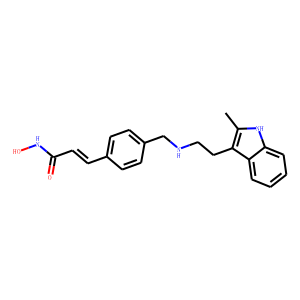| Reference | 1. Clin Cancer Res. 2009 Jun 15;15(12):4066-76. doi: 10.1158/1078-0432.CCR-08-2588. Epub 2009 Jun 9.<br />
High efficacy of panobinostat towards human gastrointestinal stromal tumors in a xenograft mouse model.<br />
Floris G(1), Debiec-Rychter M, Sciot R, Stefan C, Fieuws S, Machiels K, Atadja P, Wozniak A, Faa G, Schöffski P.<br />
Author information:<br />
(1)Department of General Medical Oncology, Laboratory of Experimental Oncology, University Hospital Gasthuisberg, University of Leuven, Leuven, Belgium. [email protected]<br />
PURPOSE: Histone deacetylase inhibitors have emerged as potent anticancer compounds. Using a nude-mouse xenograft model, for the first time we evaluated the response of human gastrointestinal stromal tumors (GIST) carrying different oncogenic KIT mutations to panobinostat (LBH589), administered single or in combination with imatinib.<br />
EXPERIMENTAL DESIGN: We grafted the human GIST882 cell line with KIT exon 13 mutation and two biopsies from patients radiologically progressing under imatinib showing KIT exon11 and KIT exon9 mutations, respectively. Our study included 4 groups: A (n = 9; control), B (n = 10; panobinostat 10 mg/kg daily, i.p.), C (n = 9; imatinib 150 mg/kg bidaily, p.o), and D (n = 8; combination panobinostat-imatinib, same dose/schedule as above). Treatment lasted 12 days. Tumor size was measured regularly using standard variables. Histopathological assessment was by H&E, and immunohistochemically with KIT, cleaved caspase-3, Ki-67, and histone acetylation staining.<br />
RESULTS: Overall, GIST xenografts responded rapidly to panobinostat as indicated by tumor regression, necrosis, hemorrhages, fibrosis, and/or myxoid degeneration, remarkable apoptosis, and substantial decline of cell proliferation. H3 and H4 acetylation increased significantly from control level in all treated groups. The combination of panobinostat and imatinib further enhanced most of the assessed parameters.<br />
CONCLUSIONS: We show for the first time potential therapeutic activity of panobinostat in human GISTs, in vivo. Our results warrant further exploration of histone deacetylase inhibitors for the treatment of advanced GISTs. Our study is also the first one on human GIST mouse xenografts established using patient biopsies.<br />
<br />
2. Future Oncol. 2009 Jun;5(5):601-12. doi: 10.2217/fon.09.36.<br />
Panobinostat (LBH589): a potent pan-deacetylase inhibitor with promising activity against hematologic and solid tumors.<br />
Prince HM(1), Bishton MJ, Johnstone RW.<br />
Author information:<br />
(1)Peter MacCallum Cancer Centre Melbourne, Melbourne, Victoria, Australia. [email protected]<br />
The deacetylase inhibitors are a structurally diverse class of targeted antineoplastic agents that have demonstrated in vitro and in vivo preclinical activity in a wide range of malignancies. Based on this preclinical activity, several deacetylase inhibitors have undergone rapid clinical development in recent years. Among these, the deacetylase inhibitor panobinostat is one of the most widely studied, with extensive pharmacokinetic, pharmacodynamic and dose-finding data available across a wide variety of hematologic and solid tumors. Furthermore, panobinostat has demonstrated favorable clinical activity against various hematologic malignancies, most notably lymphomas and myeloid malignancies in Phase I and II studies. In this article, we discuss the preclinical data on panobinostat and emerging data from Phase I and II studies in cancer patients.<br />
<br />
3. Cancer Biol Ther. 2009 May;8(10):939-50. Epub 2009 May 18.<br />
Panobinostat treatment depletes EZH2 and DNMT1 levels and enhances decitabine mediated de-repression of JunB and loss of survival of human acute leukemia cells.<br />
Fiskus W(1), Buckley K, Rao R, Mandawat A, Yang Y, Joshi R, Wang Y, Balusu R, Chen J, Koul S, Joshi A, Upadhyay S, Atadja P, Bhalla KN.<br />
Author information:<br />
(1)MCG Cancer Center, Medical College of Georgia, Augusta, GA 30912, USA.<br />
The PRC2 complex protein EZH2 is a histone methyltransferase that is known to bind and recruit DNMT1 to the DNA to modulate DNA methylation. Here, we determined that the pan-HDAC inhibitor panobinostat (LBH589) treatment depletes DNMT1 and EZH2 protein levels, disrupts the interaction of DNMT1 with EZH2, as well as de-represses JunB in human acute leukemia cells. Similar to treatment with the hsp90 inhibitor 17-DMAG, treatment with panobinostat also inhibited the chaperone association of heat shock protein 90 with DNMT1 and EZH2, which promoted the proteasomal degradation of DNMT1 and EZH2. Unlike treatment with the DNA methyltransferase inhibitor decitabine, which demethylates JunB promoter DNA, panobinostat treatment mediated chromatin alterations in the JunB promoter. Combined treatment with panobinostat and decitabine caused greater attenuation of DNMT1 and EZH2 levels than either agent alone, which was accompanied by more JunB de-repression and loss of clonogenic survival of K562 cells. Co-treatment with panobinostat and decitabine also caused more loss of viability of primary AML but not normal CD34(+) bone marrow progenitor cells. Collectively, these findings indicate that co-treatment with panobinostat and decitabine targets multiple epigenetic mechanisms to de-repress JunB and exerts antileukemia activity against human acute myeloid leukemia cells.
|

